Manifest Destiny art history definition: Unraveling the artistic legacy of this pivotal era in American history reveals a complex tapestry woven from ambitious expansion, national identity, and the often-brutal realities of westward migration. From the sweeping landscapes of the Hudson River School to the stark realism of later depictions, art served as a powerful tool, shaping public perception and justifying—or condemning—the ideology of Manifest Destiny.
This exploration delves into the artistic movements, key figures, and evolving visual narratives that defined this era, offering a critical lens through which to understand its lasting impact.
We’ll examine how artists, consciously or unconsciously, perpetuated or challenged the dominant narrative of Manifest Destiny. By analyzing the symbolism, stylistic choices, and the very subjects depicted—from idealized settlers to marginalized Native American populations—we can gain a deeper understanding of the complex social and political landscape of 19th-century America. This isn’t just a study of pretty pictures; it’s a journey into the heart of a nation’s self-image, its triumphs, and its failings.
Manifest Destiny in Art History: Manifest Destiny Art History Definition
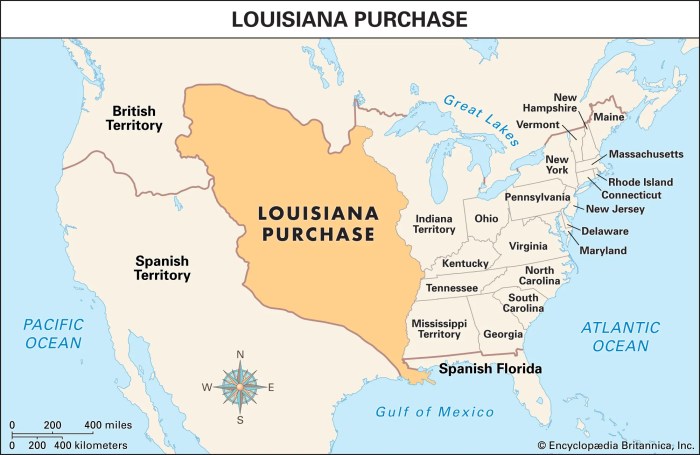
Manifest Destiny, the 19th-century belief in the divinely ordained right of the United States to expand its dominion and spread democracy across the North American continent, profoundly impacted American art. This belief system fueled a surge of artistic production that reflected, reinforced, and at times challenged the prevailing ideologies of westward expansion and national identity. This exploration delves into the complex relationship between Manifest Destiny and artistic expression, examining its representation across various artistic movements and individual artists.
Defining Manifest Destiny in Art History
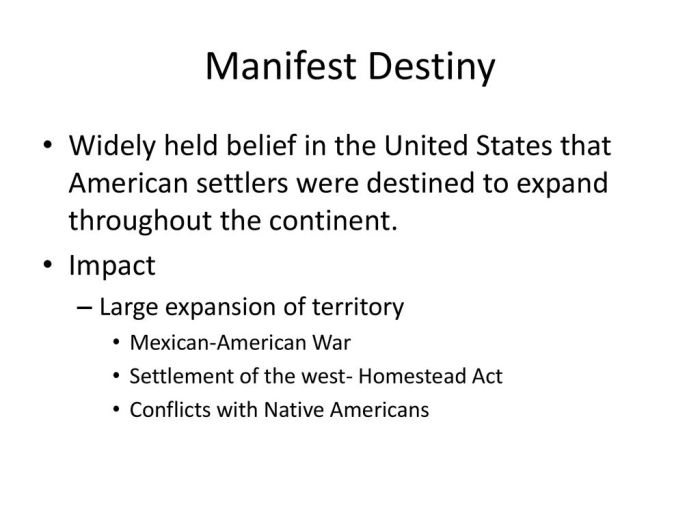
Manifest Destiny, in its simplest form, was the widely held belief in the United States that its settlers were destined to expand their dominion and spread democracy and capitalism across the entire North American continent. This belief, fueled by a sense of American exceptionalism and a conviction of racial and cultural superiority, justified westward expansion, often at the expense of Native American populations and other ethnic groups.
The concept’s influence on art is multifaceted, shaping artistic styles, subject matter, and the very narrative of American identity. The historical context of the era, marked by territorial acquisitions like the Louisiana Purchase and the Mexican-American War, provided fertile ground for artistic interpretations of this expansionist ideology. Artistic representations of Manifest Destiny varied across time periods, reflecting evolving societal attitudes and the ongoing debate surrounding the morality and consequences of westward expansion.
Artistic Movements and Manifest Destiny, Manifest destiny art history definition
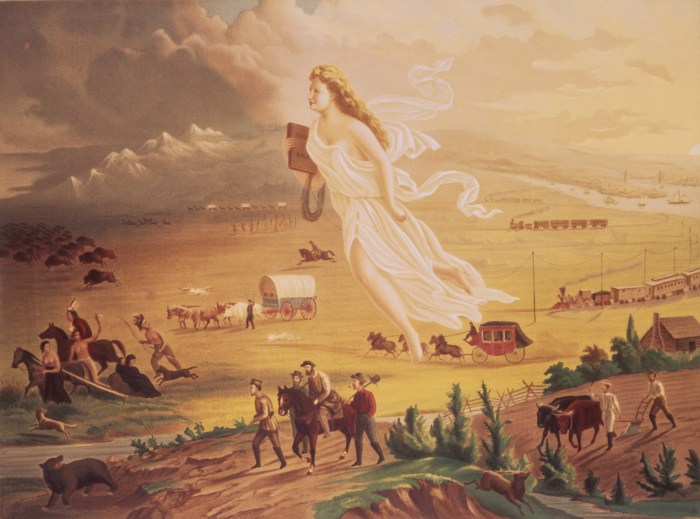
Several prominent artistic movements engaged directly with the theme of Manifest Destiny, each employing distinct stylistic approaches to convey the ideology’s complex implications. The Hudson River School, with its romanticized landscapes, and American Realism, with its focus on social realities, stand out as key examples. These movements utilized specific artistic techniques—from the sublime grandeur of the Hudson River School to the stark realism of later works—to convey the perceived glories and harsh realities of westward expansion.
| Movement | Style | Positive Depiction Examples | Negative Depiction Examples |
|---|---|---|---|
| Hudson River School | Romantic landscape painting, emphasizing sublime beauty and the untouched wilderness. | Vast, awe-inspiring landscapes depicting the untouched beauty of the American West, often featuring idealized depictions of settlers interacting harmoniously with nature. | Limited; while not explicitly negative, the exclusion of Native Americans or the depiction of them as obstacles to progress could be interpreted negatively. |
| American Realism | Focus on accurate representation of everyday life, including its harsh realities. | Depictions of the challenges faced by settlers, showcasing their resilience and determination. | Images depicting the violence and displacement of Native Americans, the exploitation of resources, and the social inequalities resulting from westward expansion. |
Key Artists and their Representations
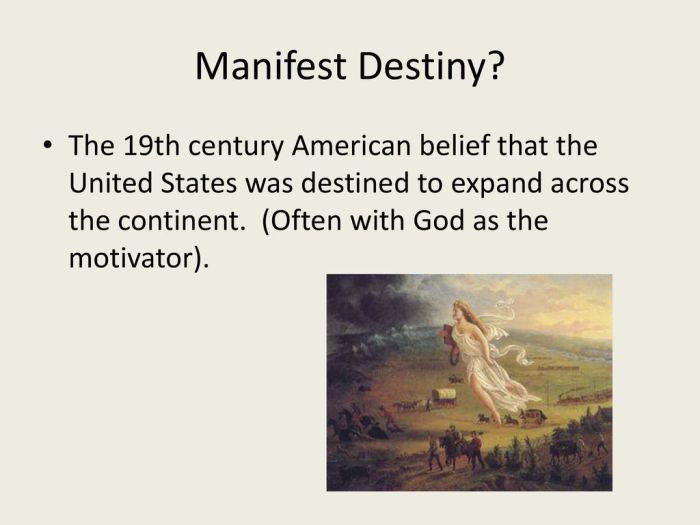
Several artists played a pivotal role in shaping the visual narrative of Manifest Destiny. Their personal beliefs significantly influenced their artistic interpretations of westward expansion, leading to diverse and sometimes conflicting portrayals. Analyzing their individual styles and symbolic choices offers valuable insights into the multifaceted nature of this historical phenomenon.
Albert Bierstadt, known for his dramatic and romanticized landscapes of the American West, often depicted scenes of breathtaking natural beauty, emphasizing the grandeur of the untamed wilderness. His personal experiences traveling through the West deeply influenced his work, shaping his vision of the region’s potential and inspiring awe in his viewers. For instance, his painting “Among the Sierra Nevada, California” (1868) showcases the immense scale of the landscape, emphasizing its untouched beauty and suggesting the boundless possibilities of westward expansion.
The use of dramatic lighting and vast scale contributes to a sense of awe and wonder, conveying the perceived magnificence of the American West.
George Catlin, a painter and ethnographer, documented the lives of Native American tribes in the 19th century. While often sympathetic to their plight, his work also reflected the prevalent biases of the time. His paintings, such as those from his series “North American Indian Portfolio,” present a romanticized yet often stereotypical view of Native American cultures, highlighting their traditions and customs while simultaneously contributing to the narrative of a disappearing way of life.
The detailed portrayal of clothing, rituals, and daily life aims for accuracy, but it’s important to note the context of colonial encounters and the inherent power dynamics involved.
Thomas Moran, another prominent figure of the Hudson River School, is celebrated for his large-scale landscapes that capture the grandeur of the American West. His paintings, such as “The Grand Canyon of the Yellowstone” (1872), served to promote the preservation of national parks and fueled public interest in exploring the vastness of the American landscape. His work, while aesthetically stunning, also contributes to the broader narrative of Manifest Destiny, presenting the untouched landscape as a symbol of national pride and potential.
A comparison of Bierstadt and Moran reveals a shared aesthetic sensibility within the Hudson River School, both emphasizing the sublime beauty of the American West. However, their individual approaches differed. Bierstadt often focused on dramatic compositions and intense color palettes, emphasizing the grandeur and power of nature, while Moran’s style was more nuanced, capturing the subtle details and textures of the landscape, conveying a sense of tranquility and awe.
Both, however, contributed to the idealized vision of the American West that fueled the ideology of Manifest Destiny.
Manifest Destiny’s Visual Narrative

The visual representation of Manifest Destiny relied heavily on specific elements to construct its narrative of westward expansion and national identity. These visual elements, used consistently across various artistic movements, helped shape public perception and understanding of the era’s events and ideology.
- Landscapes: Vast, awe-inspiring landscapes dominated Manifest Destiny art, symbolizing the boundless potential of the American West and the nation’s destiny to conquer it.
- Settlers: Depictions of settlers, often portrayed as hardworking and virtuous pioneers, reinforced the narrative of progress and civilization’s triumph over wilderness.
- Native Americans: The portrayal of Native Americans varied widely, often ranging from romanticized depictions to portrayals that marginalized and demonized them as obstacles to progress.
Landscape painting played a crucial role in shaping public perception of Manifest Destiny. By showcasing the beauty and vastness of the American West, these paintings instilled a sense of national pride and encouraged westward expansion. The idealized depictions of nature often obscured the realities of environmental destruction and displacement of Native American populations.
Evolution of the visual representation of Native Americans in art related to Manifest Destiny:
- Early depictions: Often romanticized or exoticized, focusing on idealized notions of “noble savages.”
- Mid-19th century: Increasingly portrayed as obstacles to progress and westward expansion, often depicted in stereotypical and negative ways.
- Late 19th and early 20th centuries: Images often reflect the consequences of westward expansion on Native American communities, including displacement, loss of land, and cultural destruction.
- Contemporary art: A more nuanced and critical perspective emerges, acknowledging the injustices and complexities of the historical relationship between settlers and Native Americans.
The Legacy and Critique of Manifest Destiny Art
Manifest Destiny art served as a powerful reflection of the prevailing social and political attitudes of its time, reinforcing the dominant narratives of westward expansion and national identity. However, the artistic representations of Manifest Destiny have also faced significant criticism for their inherent biases, omissions, and glorification of violence and displacement. The lasting impact of Manifest Destiny art on American cultural identity is undeniable, continuing to shape our understanding of the nation’s history and its relationship with its indigenous populations.
Contemporary artists continue to engage with and critique the legacy of Manifest Destiny, offering new perspectives and challenging the dominant narratives.
“This artwork challenges the traditional narratives of Manifest Destiny by focusing on the experiences of Native Americans who were displaced and marginalized during westward expansion.”
The above quote exemplifies a contemporary artistic response to the historical injustices associated with Manifest Destiny, providing a counter-narrative to the romanticized versions presented in earlier art.
“This piece uses a fragmented and abstract style to represent the broken treaties and the fragmented lives of those affected by Manifest Destiny.”
This example showcases the use of artistic techniques to express the complex and traumatic consequences of Manifest Destiny. The abstract style serves to emphasize the disruption and chaos experienced by those impacted by westward expansion.
Manifest Destiny and its Impact on Different Ethnic Groups
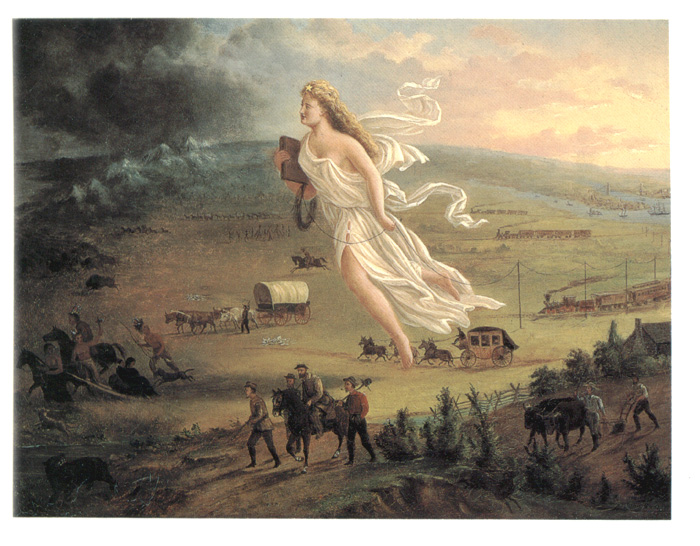
Manifest Destiny art depicted a wide range of ethnic groups, each portrayed with varying degrees of accuracy and sensitivity. The artistic representations of these groups often reflected and reinforced prevailing societal biases and stereotypes, contributing to the complex historical narratives surrounding westward expansion.
Native Americans were frequently depicted in stereotypical ways, often as obstacles to progress or as vanishing cultures. Their portrayal frequently lacked nuance and failed to acknowledge the diversity of their cultures and experiences. European Americans, on the other hand, were typically portrayed as virtuous pioneers, embodying the ideals of hard work, determination, and progress. Mexican Americans, as a result of the Mexican-American War, were often depicted negatively or marginalized in the artistic representations of Manifest Destiny.
The biases and stereotypes present in these artistic depictions had a profound impact on the historical narratives surrounding Manifest Destiny. These images contributed to a skewed understanding of the events of the era, often overlooking the violence, displacement, and injustices suffered by Native Americans and other marginalized groups. The legacy of these portrayals continues to shape contemporary perceptions of this pivotal period in American history.
Epilogue

Ultimately, understanding the art of Manifest Destiny is crucial to grasping the complexities of American history. The paintings, sculptures, and other artistic expressions of this era weren’t merely aesthetic creations; they were powerful instruments of propaganda, shaping public opinion and influencing the course of events. By critically examining these works, we can better understand the enduring legacy of Manifest Destiny, its impact on American identity, and the ongoing conversations surrounding its ethical implications.
The visual record provides invaluable insight into the narratives that were promoted and the perspectives that were suppressed, leaving us with a rich, albeit often troubling, historical legacy to interpret.
FAQ Insights
What specific techniques did artists use to portray the “positive” aspects of Manifest Destiny?
Artists often employed idealized landscapes, showcasing abundant natural resources and portraying settlers as virtuous pioneers. Dramatic lighting and heroic poses further enhanced this positive narrative.
How did the portrayal of Native Americans change over time in Manifest Destiny art?
Early depictions often romanticized Native Americans, while later representations became increasingly stereotypical and negative, reflecting changing attitudes and the escalating conflicts between settlers and indigenous populations.
What are some examples of contemporary art that engages with the legacy of Manifest Destiny?
Contemporary artists often revisit Manifest Destiny themes to critique its inherent biases and the lasting impact of westward expansion on indigenous populations and the environment. Many use their work to highlight the untold stories and forgotten perspectives.
Were there any artists who actively challenged the dominant narrative of Manifest Destiny?
Yes, some artists, though fewer in number, created works that depicted the negative consequences of westward expansion, such as the displacement and suffering of Native American communities, environmental destruction, and the exploitation of resources.